Itteringham Mill
Hydroelectric Generator
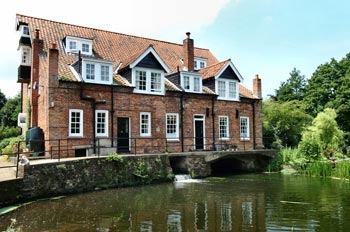
Itteringham Mill micro-hydro-turbine went live at the
end of November 2006. The turbine will effectively
make the Mill self-sufficient with regard to
electricity and, if a heatpump and underfloor heating
is installed as planned, eliminate the burning of oil
for central heating. Other green plans in the
pipeline are for solar hot water.
The turbine produces a peak output of 5kW, However
local conditions in the river (volume of flow, amount
of weed growth, capacity of the river immediately
downstream of the turbine) currently restrict output
to a maximum of 4.7kW, and more regularly we achieve
between 3.2 and 4 kW.
The installation was the culmination of 2 years of
planning that started with Derwent Hydro carrying out
a feasibility study in late 2005 and recommending a
siphonic turbine in a new culvert next to the mill by-pass
weir. The Environment Agency awarded a licence for
the work in early 2006 and the local authority gave
planning permission shortly thereafter. We were also
required to invite Norfolk Wildlife Trust to the site
to investigate the presence of water voles and to
recommend actions to mitigate the effect of the civil
works on the water-vole population.
The design and fabrication of the new culvert was a
bit of a headache particularly as local contractors
estimated civil works would be an additional 40% on
top of the capital cost of the equipment, which would
have made the whole affair very uneconomic.. Luckily
Lis's brother Charles had contacts in the steel
fabrication business and we were able to have a
culvert made in 3mm stainless steel for a much more
attractive price thanks to Jeff Curtis of George Green
and Co. This was installed in August 2006 with the
aid of local digger wizard John from Lloyd Coles Plant
Hire, steel fabricator Brian Alexandra (who had
actually made the culvert and driven it down from the
far north), Charles Freeman (Lis's brother) and
myself.
John dug the hole leaving the river bank intact one
day, and in the evening we laid a bed of levelled
peagravel in the base. The following day Jeff arrived
with the sections by 11:00am and they were manhandled
to the site, craned into place and bolted together.
We put a stop log across the entrance of the culvert
to prevent mud being washed in when the bank was
removed. With everything bolted together and
beautifully level we gave John the order to remove the
river bank. "Won't it float?" he asked, but
unfortunately not in a demanding enough tone. Of
course, it did! A brief moment of panic as we
stuggled to remove the stop log and let the water in
unhindered then it settled back down - but regretfully
not as level as it had been before. Too late to do
anything about it now, so it continues to offend my
eyes.
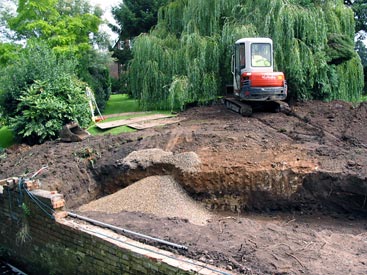
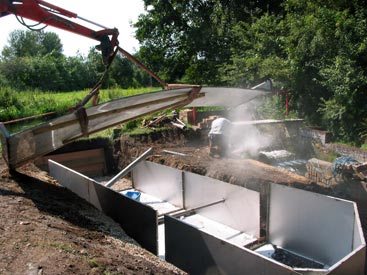
Next activity was to build the base on which the
turbine would sit, a structure of hollow concrete
blocks with reinforcing steel filled with further
concrete. Best mate Roger came up for the weekend to
help, not realising that we were going to have to hand
mix and transport a couple of tons of concrete. I
still don't know why we didn't hire a mixer - perhaps
we thought we needed the exercise.
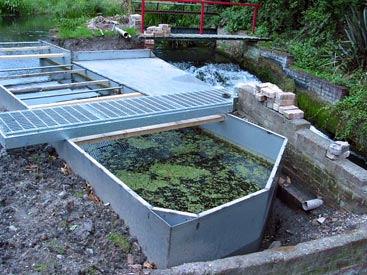
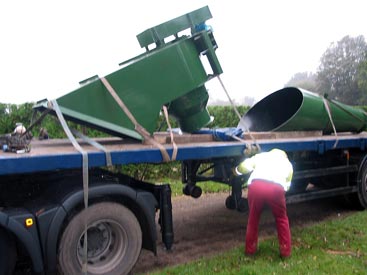
We then waited, slightly anxiously because of
approaching deadlines for claiming the available
grant, for the turbine and control panel to be
manufactured, delivered to site and connected up.
This was achieved with about 7 days to spare. John
from Lloyd Coles again providing invaluable help to
the guys from Derwent Hydro.
In March 2007 we finally got our export meter
installed thanks to EDF. We await our first negative
value electricity bill.
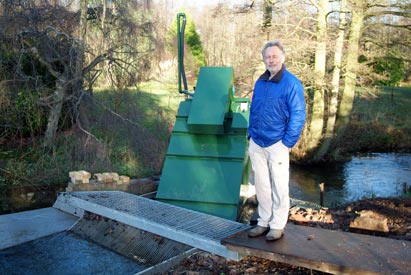
As with most custom built things the turbine and
control panel (a mass of electronics) have had a few
teething problems. These seem to have been fixed.
During the very dry period in March-April 2007 when
the turbine was taking more water than was coming down
the river it coped admirably well with constant
switching on and off to allow river levels to
replenish.
All that remains is the regular monitoring of the
weedscreen to ensure it does not get clogged by
leaves, branches, dead cormorants; and significant
efforts to enhance the flow of water away from the
turbine to maximise our output. Not exactly a life of
leisure but we can have the smug feeling that we are
doing a little bit to combat climate change.
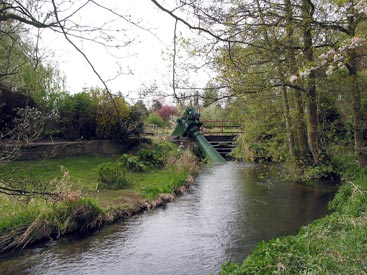
Don't feel jealous though when you are suffering from a power cut. Regulations associated with safety of powerline workers mean that when there is a power cut our turbine has to shut down.
Peter Downs - 25th May 2007